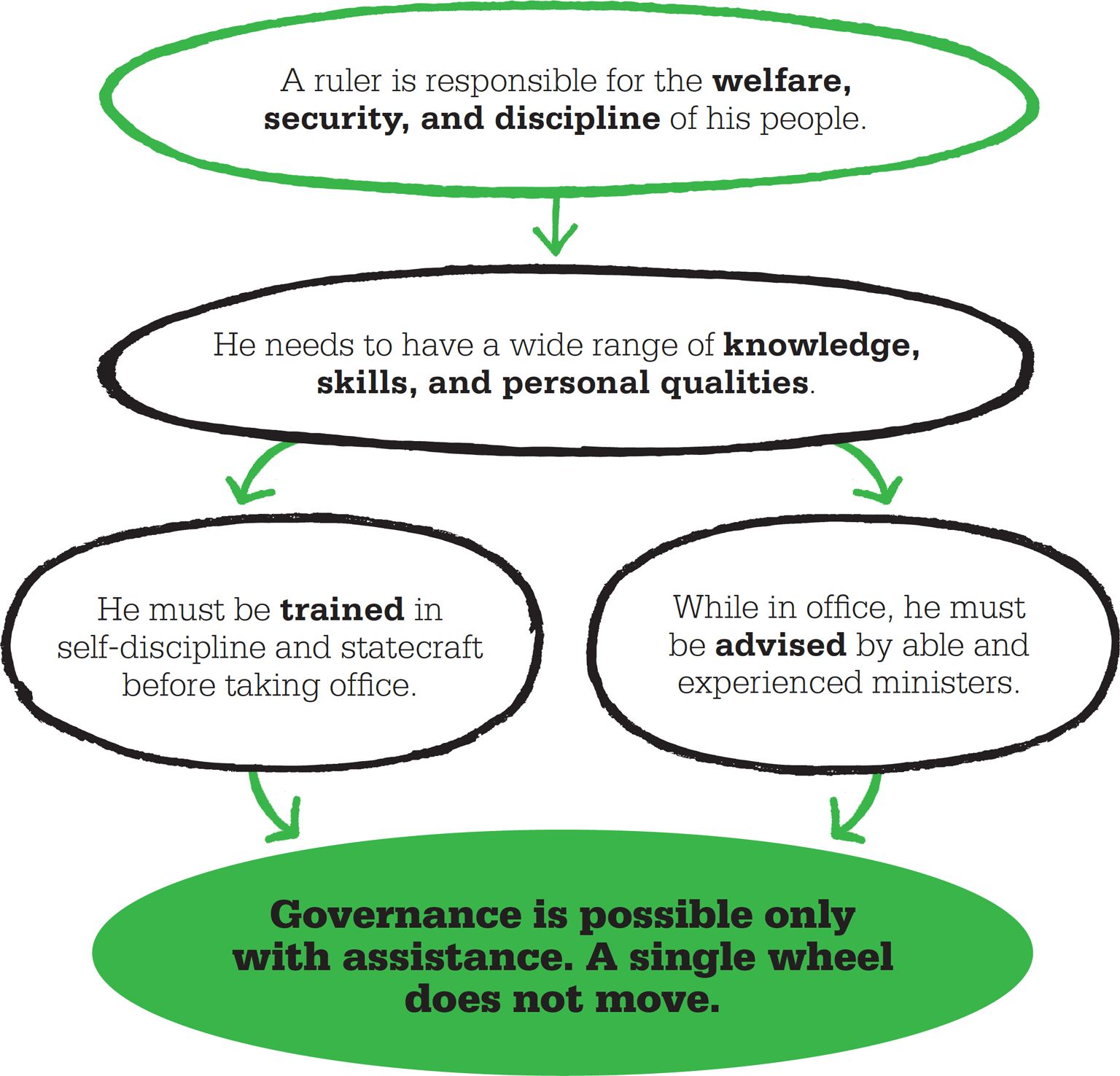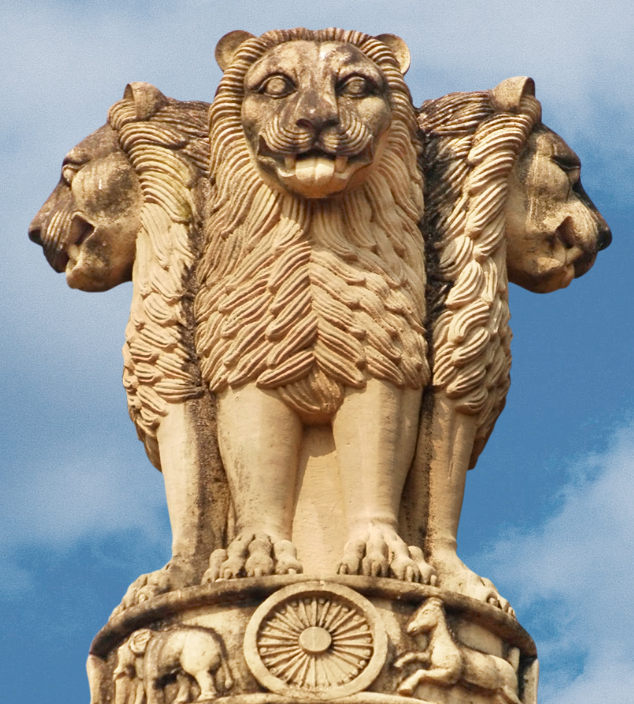
IN CONTEXT
Realism
Utilitarian
6th century BCE The Chinese general Sun Tzu writes his treatise The Art of War, bringing an analytical approach to statecraft.
424 BCE Mahapadma Nanda establishes the Nanda dynasty in India, and relies on his generals for tactical advice.
c.65 BCE The Mauryan empire, which Chanakya helped to found, reaches its height and rules over all but the southern tip of the Indian subcontinent.
1904 Texts of Chanakya’s treatises are rediscovered and, in 1915, are translated into English.
During the 5th and 4th centuries BCE, the Nanda dynasty slowly gained control over the northern half of the Indian subcontinent, defeating its rivals one by one and holding off the threat of invasion by the Greeks and Persians from the west. The rulers of this expanding empire relied on generals for tactical advice in battle, but they also began to recognize the value of ministers to advise on matters of policy and government. Scholars, especially those from Takshashila, a university established c.600 BCE in Rawalpindi, now part of Pakistan, frequently became these ministers.

Many important thinkers developed their ideas at Takshashila, but perhaps the most significant was Chanakya (also known as Kautilya and Vishnugupta). He wrote a treatise on statecraft titled Arthashastra, meaning “the science of material gain” or “the art of polity.” Arthashastra combined the accumulated wisdom of the art of politics with Chanakya’s own ideas, and was remarkable in its dispassionate, and at times ruthless, analysis of the business of politics.

The lion capital of Ashoka stood on top of a pillar in Sarnath at the center of the Mauryan empire. Chanakya helped to found this powerful empire, which came to rule nearly all of India.
Advising the sovereign
Although sections of the treatise dealt with the moral qualities desirable in the leader of a state, the emphasis was on the practical, describing in direct terms how power could be gained and maintained, and for the first time in India, it explicitly described a civil structure in which ministers and advisors played a key role in the running of the state.
A commitment to the prosperity of the state lies at the heart of Chanakya’s political thought, and he makes repeated references to the welfare of the people as the ultimate goal of government. This, he believed, was the responsibility of a sovereign who would ensure his people’s well-being and security by administering order and justice, and leading his country to victory over rival states. The power to carry out his duties to his country and its people is dependent on several different factors, which Chanakya describes in Arthashastra: the personal qualities of the ruler, the abilities of his advisors, his territory and towns, his wealth, his army, and his allies.
The sovereign, as head of state, has the central role in this system of government. Chanakya emphasizes the importance of finding a ruler with the appropriate qualities, but then goes on to say that personal qualities of leadership are not sufficient on their own: the sovereign must also be trained for the job. He must learn the various skills of statecraft, such as military tactics and strategy, law, administration, and the arts of diplomacy and politics, but in addition he should be taught the skills of self-discipline and ethics in order to develop the moral authority necessary to command the loyalty and obedience of his people. Before taking office, the sovereign needs assistance from experienced and knowledgable teachers.
Once instated, a wise sovereign does not rely solely on his own wisdom, but can turn to trusted ministers and advisors for counsel. In Chanakya’s view, such individuals are as important as the sovereign in governing the state. In Arthashastra, Chanakya states: “Governance is possible only with assistance—a single wheel does not move.” This is a warning to the sovereign not to be autocratic, but to arrive at decisions of state after consulting his ministers.
"All things begin with counsel."
Chanakya
The appointment of ministers with the necessary qualifications is therefore just as important as the people’s choice of leader. The ministers can provide a range of knowledge and skills. They must be utterly trustworthy, not only so that the sovereign can rely on their advice, but also to ensure that decisions are made in the interests of the state and its people—if necessary, preventing a corrupt ruler from acting in his own interests.

In Chanakya’s analogy, the state is like a chariot with the sovereign forming one wheel and his ministers making up the other; in order to move and be steered in the right direction, the chariot needs both wheels.
The end justifies the means
It was this recognition of the realities of human nature that distinguished Chanakya from other Indian political philosophers of the time. Arthashastra is not a work of moral philosophy, but a practical guide to governance, and in ensuring the welfare and security of the state it often advocates using whatever means are necessary. Although Arthashastra advocates a regime of learning and self-discipline for an ideal ruler, and mentions certain moral qualities, it doesn’t flinch from describing how to use underhanded methods to gain and maintain power. Chanakya was a shrewd observer of human weaknesses as well as strengths, and he was not above exploiting these to increase the sovereign’s power and undermine that of the sovereign’s enemies.
"Through ministerial eyes others’ weaknesses are seen."
Chanakya
This is particularly noticeable in his advice on defending and acquiring territory. Here he recommends that the ruler and his ministers should carefully assess the strength of their enemies before deciding on a strategy to undermine them. They can then choose from a number of different tactics, ranging from conciliation, encouraging dissent in the enemy’s ranks, and forming alliances of convenience with other rulers, to the simple use of military force. In deploying these tactics, the ruler should be ruthless, using trickery, bribery, and any other inducements deemed necessary. Although this seems contradictory to the moral authority Chanakya advocates in a leader, he stipulates that after victory has been achieved, the ruler should “substitute his virtues for the defeated enemy’s vices, and where the enemy was good, he shall be twice as good.”
Intelligence and espionage
Arthashastra reminds rulers that military advisors are also needed, and the gathering of information is important for decision-making. A network of spies is vital in assessing the threat posed by neighboring states, or to judge the feasibility of acquiring territory; but Chanakya goes further, suggesting that espionage within the state is also a necessary evil in order to ensure social stability. At home and in international relations, morality is of secondary importance to the protection of the state. The state’s welfare is used as justification for clandestine operations, including political assassination, should this be necessary, aimed at reducing the threat of opposition.
This amoral approach to taking and holding on to power, and the advocacy of a strict enforcement of law and order, can be seen either as shrewd political awareness or as ruthlessness, and has earned Arthashastra comparison with Machiavelli’s The Prince, written around 2,000 years later. However, the central doctrine, of rule by a sovereign and ministers, has more in common with Confucius and Mozi, or Plato and Aristotle, whose ideas Chanakya may have come across as a student in Takshashila.

Elephants played a big role in Indian warfare, often terrifying enemies so much that they would withdraw rather than fight. Chanakya developed new strategies for warfare with elephants.
A proven philosophy
The advice contained in the pages of Arthashastra soon proved its usefulness when adopted by Chanakya’s protegé Chandragupta Maurya, who successfully defeated King Nanda to establish the Mauryan empire in around 321 BCE. This became the first empire to cover the majority of the Indian subcontinent, and Maurya also successfully held off the threat from Greek invaders led by Alexander the Great. Chanakya’s ideas were to influence government and policy-making for several centuries, until India eventually succumbed to Islamic and Mughal rule in the Middle Ages.
The text of Arthashastra was rediscovered in the early 20th century, and regained some of its importance in Indian political thinking, gaining iconic status after India won independence from Great Britain in 1948. Despite its central place in Indian political history, it was little known in the West, and it is only recently that Chanakya has been recognized outside India as a significant political thinker.
CHANAKYA
The birthplace of Indian scholar Chanakya is not certain. It is known that he studied and taught in Takshashila (modern Taxila, Pakistan). Leaving Takshashila to become involved in government, he traveled to Pataliputra, where he became an advisor to King Dhana Nanda. There are many conflicting accounts of what happened next, but all agree that he left the Nanda court after a dispute, and in revenge groomed the young Chandragupta Maurya to be Nanda’s rival. Chandragupta overthrew Dhana Nanda and founded the Mauryan empire, which governed all of modern India except the very south. Chanakya became chief advisor to Chandragupta, but is said to have starved himself to death after being falsely accused by Chandragupta’s son, Bindusara, of poisoning his mother.
Key works
4th century BCE
Arthashastra
Neetishastra
